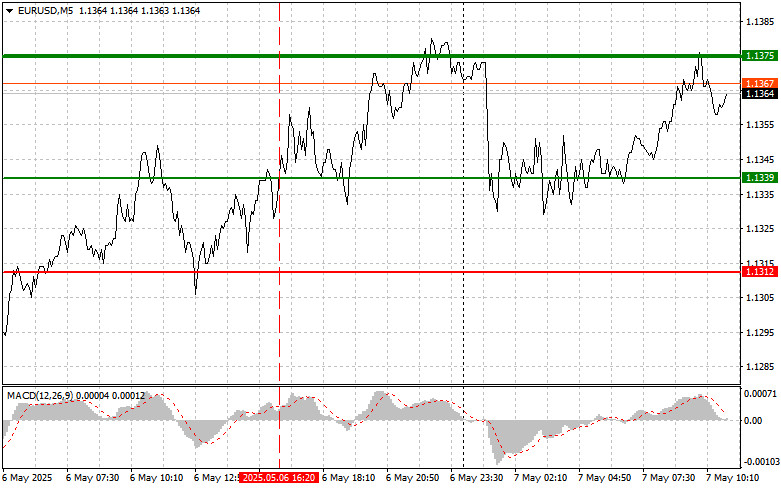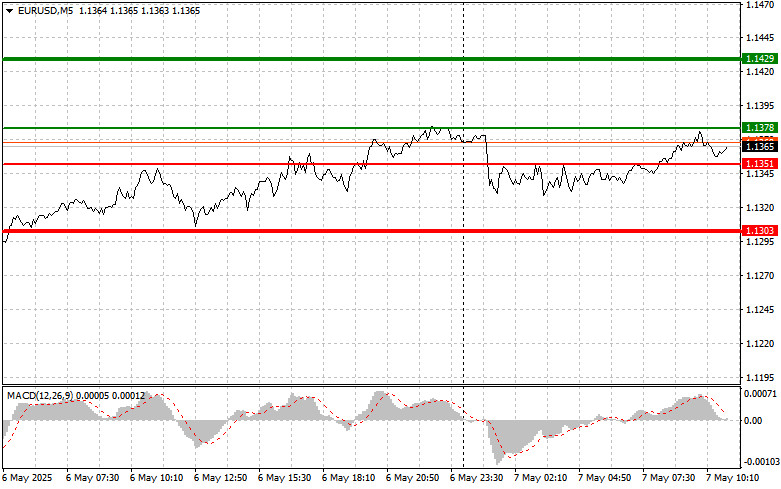Analysis of Trades and Trading Tips for the Euro
The price test at 1.1339 in the second half of the day coincided with the MACD indicator having already moved significantly above the zero line, which limited the pair's upward potential. For this reason, I chose not to buy the euro.
The release of data showing a negative U.S. trade balance triggered a weakening of the U.S. dollar, pushing the euro higher. Investors interpreted these figures as a sign of a slowdown in U.S. economic growth, reducing the dollar's investment appeal. Previously, the euro had already strengthened in response to strong PMI index data, setting the market's tone. Soon, the dollar's trajectory will depend on upcoming U.S. macroeconomic data and whether the Federal Reserve decides to ease its monetary policy—if so, the dollar may continue to lose ground.
In the first half of the day, market attention will focus on the eurozone's retail sales figures for March. This release is a subtle barometer of consumer demand—the core of the European economy. Retail sales data are not just dry statistics; they reflect the sentiment of millions of consumers, their confidence in the future, and their willingness to spend, which either drives or slows the economy. Weak figures may trigger euro sell-offs and heighten recession fears. On the other hand, a strong report will inspire optimism and push the euro to new highs.
For intraday strategy, I will focus primarily on Scenarios #1 and #2.
Buy Scenario
Scenario #1: Today, I plan to buy the euro if the price reaches around 1.1378 (green line on the chart), to rise to 1.1429. At 1.1429, I plan to exit the market and open a short position in the opposite direction, aiming for a move of 30–35 pips from the entry point. A strong rally in the euro in the first half of the day is unlikely.
Important: Before buying, ensure that the MACD indicator is above the zero line and beginning to rise.
Scenario #2: I also intend to buy the euro today if the price tests 1.1351 twice consecutively while the MACD indicator is in the oversold zone. This will limit the pair's downside potential and lead to an upward reversal. A rise to resistance levels at 1.1378 and 1.1429 can be expected.
Sell Scenario
Scenario #1: I plan to sell the euro after the price reaches the 1.1351 level (red line on the chart). The target will be 1.1303, where I plan to exit the market and open a long position in the opposite direction, aiming for a 20–25 pip rebound from the level. Selling pressure on the pair may return at any moment.
Important: Before selling, ensure that the MACD indicator is below the zero line and beginning to decline.
Scenario #2: I also intend to sell the euro today if the price tests the 1.1378 level twice consecutively while the MACD indicator is in the overbought zone. This will limit the pair's upward potential and lead to a downward market reversal. A decline to the opposite levels at 1.1351 and 1.1303 can be expected.
What's on the Chart:
- The thin green line represents the entry price where the trading instrument can be bought.
- The thick green line indicates the expected price level where a Take Profit order can be placed, or profits can be manually secured, as further price growth above this level is unlikely.
- The thin red line represents the entry price where the trading instrument can be sold.
- The thick red line indicates the expected price level where a Take Profit order can be placed, or profits can be manually secured, as further price decline below this level is unlikely.
- The MACD indicator should be used to assess overbought and oversold zones when entering the market.
Important Notes:
- Beginner Forex traders should exercise extreme caution when making market entry decisions. It is advisable to stay out of the market before the release of important fundamental reports to avoid exposure to sharp price fluctuations. If you choose to trade during news releases, always use stop-loss orders to minimize potential losses. Trading without stop-loss orders can quickly wipe out your entire deposit, especially if you neglect money management principles and trade with high volumes.
- Remember, successful trading requires a well-defined trading plan, similar to the one outlined above. Making impulsive trading decisions based on the current market situation is a losing strategy for intraday traders.














